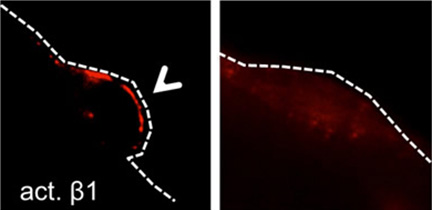
New research in mice, funded in part by the NIH’s National Institute of Arthritis and Musculoskeletal and Skin Diseases (NIAMS), has revealed that interactions between muscle stem cells and their immediate external environment deteriorate with aging, hampering muscle repair. The findings, which appeared in two companion papers in the journal, Nature Medicine, suggest that enhancing these connections could help maintain muscle strength in older adults and promote muscle repair in people with diseases such as Duchenne muscular dystrophy.
Aging comes with a gradual loss of skeletal muscle strength and slowed recovery from muscle injuries, which together can significantly affect a person’s mobility. Skeletal muscle is maintained by stem cells called satellite cells, which serve as a reserve population of cells that can multiply and give rise to new muscle in response to injury. A number of studies have shown that satellite cells lose their capacity to renew themselves and regenerate muscle with age, however, the mechanisms underlying this decline have been unclear.
To gain a better understanding of how aging alters satellite cell function, researchers led by Chen-Ming Fan, Ph.D., of the Carnegie Institution for Science, focused on a type of molecule called β1-integrin. Integrins lie in the cell membrane and act like bridges between the outside and inside of cells, relaying signals from the cell’s environment and triggering responses such as proliferation or migration. β1-integrin is present at high levels in satellite cells, which led the researchers to wonder about its role in these cells.
Dr. Fan’s team’s first indication that β1-integrin could be important to satellite cell function came from experiments using cells they’d engineered to lack the molecule. In the absence of β1-integrin, satellite cell numbers declined over time compared to controls that produce the molecule. In addition, without β1-integrin, cells were less able to multiply and regenerate muscle in response to injury.
The reduced ability of cells missing β1-integrin to proliferate paralleled what had previously been observed in aging satellite cells, suggesting that the molecule plays a role in the age-related decline in satellite cell function. Indeed, the team found that β1-integrin activity is dampened in older satellite cells relative to young ones.
To examine β1-integrin’s role in muscle, the researchers artificially stimulated the molecule in muscles of mice using a β1-integrin-activating antibody. The antibody promoted muscle regeneration in older mice, while young mice were largely unaffected by the treatment. Similarly, treatment with the β1-integrin-activating antibody stimulated muscle growth in mice with the muscle disease, Duchenne muscular dystrophy, with a concomitant boost in muscle strength. These results showed that β1-integrin is important for restoring aging or diseased muscle.
β1-integrin helps relay growth and proliferation signals by interacting with molecules outside the cell. In the second study, Dr. Fan’s group, along with another team of researchers led by C. Florian Bentzinger, Ph.D., and Jerome N. Feige, Ph.D., of the Nestlé Institute of Health Sciences, discovered that one of these extracellular molecules, fibronectin, is involved in controlling satellite cell behavior. The investigators observed lower levels of fibronectin in skeletal muscle tissue from aged mice compared to their younger counterparts, along with fewer satellite cells.
Injecting fibronectin into muscles of older mice boosted satellite cell numbers and sped up muscle repair following injury, revealing a key role for the molecule in muscle maintenance. Additional experiments showed that fibronectin specifically binds and activates β1-integrin, indicating that the two molecules work together to promote satellite cell proliferation and muscle maintenance.
By uncovering the part played by the fibronectin/β1-integrin interaction in muscle repair, this work has provided researchers with promising therapeutic targets for combating muscle degeneration in older people and individuals with certain muscle diseases.
"As we age, the function and regenerative capacity of our skeletal muscles decline, which makes it harder for older people to recover from injury or surgery," said Dr. Fan. "This is a significant clinical problem, and we badly need new therapeutic approaches for improving muscle function in our aging population."
The β1-integrin paper was supported by the NIH’s NIAMS [grant R01-AR060042] and Eunice Kennedy Shriver National Institute of Child Health and Human Development (NICHD) [grant F31-HD075345]. The Carnegie Institution For Science also provided support.
The fibronectin paper was supported by the NIH’s NIAMS [grant R01-AR060042] and NICHD [grant F31-HD075345]. The German Research Foundation, the Government of Ontario Ministry of Research and Innovation, and the Fondation Suisse de Recherche sur les Maladies Musculaires also provided support.
Targeting β1-integrin signaling enhances regeneration in aged and dystrophic muscle in mice. Rozo M, Li L, Fan CM. Nat Med. 2016 Aug; 22(8):889-96. doi: 10.1038/nm.4116. Epub 2016 Jul 4. PMID: 27376575
Loss of fibronectin from the aged stem cell niche affects the regenerative capacity of skeletal muscle in mice. Lukjanenko L, Jung MJ, Hegde N, Perruisseau-Carrier C, Migliavacca E, Rozo M, Karaz S, Jacot G, Schmidt M, Li L, Metairon S, Raymond F, Lee U, Sizzano F, Wilson DH, Dumont NA, Palini A, Fässler R, Steiner P, Descombes P, Rudnicki MA, Fan CM, von Maltzahn J, Feige JN, Bentzinger CF. Nat Med. 2016 Aug;22(8):897-905. doi: 10.1038/nm.4126. PMID: 27376579
The mission of the NIAMS, a part of the U.S. Department of Health and Human Services' National Institutes of Health, is to support research into the causes, treatment and prevention of arthritis and musculoskeletal and skin diseases; the training of basic and clinical scientists to carry out this research; and the dissemination of information on research progress in these diseases. For more information about the NIAMS, call the information clearinghouse at (301) 495-4484 or (877) 22-NIAMS (free call) or visit the NIAMS website at https://www.niams.nih.gov.
